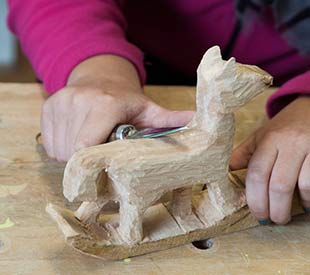The EU-funded project “Art School ‘Walk’” established a common cultural cross-border educational centre between the twin cities of Valka in Latvia and Valga in Estonia. The centre provides Estonian and Latvian children with an education in art in their native tongue, while enabling all students to study in the same building. There are now six cross border education classes offered in Estonian at the Latvian Valka Art School – drawing, painting, composition, art history, wood, cutting and modelling.
Cross-border education proves a work of art for Latvia and Estonia
- 23 November 2017
Valka Municipality Council and Valga Town Government coordinated a creative project where they brought together youngsters and art lovers interested in art education. The twin town governments created an opportunity for youngsters to study art in one place, but in their own language by developing Valka Art School into a common cross-border educational centre. In addition, several common cultural educational events were carried out during the project.
In its first year, the Valka Art School enrolled 18 Estonian students, aged between nine and 14. This number increased to 25 in the following year. Five common cultural educational events have been organised — four for students and one for teachers from art education institutions. An exchange trip was organised for five participants to travel to Tornio in Finland and Haparanda in Sweden.
Art for everyone
The Valka Art School classrooms were furnished with the equipment and study materials needed during the project, which was implemented during 2012-2013. Every year, 230 to 260 students attend the school, out of which about 120 come from Estonia and from them about 25 attend classes providing teaching in Estonian.
Thus, art lovers interested in art education have an opportunity to receive certified education in art and art-related subjects in their native language (Latvian, Estonian or Russian).The project has given a centralised location for the local art enthusiasts in the area. It has also raised the level of art education in Valga significantly.
Valka and Valga may be separated by a border, but they share one motto – ‘One Town, Two Countries’. The Valka Municipality Programme and the Valga Town Government have previously organised cross border projects in the spheres of culture, sport, education, social and health. However Valka Art School is the only art educational institution offered in the twin cities.
Integrating Estonian and exchanging experiences
Before the project, Estonian students were unable to pursue art education, because there were no native speaking teachers in the school. To change this, three Estonian teachers and a deputy headmaster were hired to facilitate Estonian studies. Multiple class programmes were translated into Estonian; the school rules were also translated. The project benefits these teachers, as it gives them the opportunity to work near their homes, instead of having to move to bigger cities to find work.
The exchange trip allowed the Valka-Valga visitors to see neighbouring cities, which are involved in their own cross border art education programmes. They shared their invaluable experiences, knowledge and best practises in cross border cooperation. The project organised even cultural educational events, most notably a graffiti masterclass for Estonian and Latvian children.
Total investment and EU funding
Total investment for the project “Art School Walk” is EUR 122 429, with the EU’s European Regional Development Fund contributing EUR 83 292 through the “Estonia - Latvia” Operational Programme for the 2007-2013 programming period.

